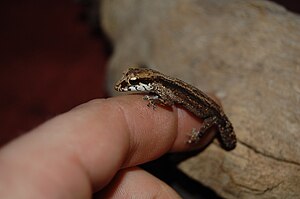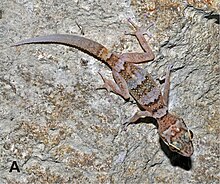Paroedura
| Paroedura | ||||||||||||
|---|---|---|---|---|---|---|---|---|---|---|---|---|

|
||||||||||||
| Systematics | ||||||||||||
|
||||||||||||
| Scientific name | ||||||||||||
| Paroedura | ||||||||||||
| Günther , 1879 |

Paroedura is a genus within the gecko family.
features
The 17 currently described species of the genus differ morphologically very much, especially in body size. Dixon and Kroll examined 89 specimens of the Phyllodactylus species from Madagascar and found that these were a natural group. These species differ markedly from all other Phyllodactylus species, so Dixon and Kroll restored the genus Paroedura as valid. The species in Madagascar all have a more or less helmet-like skull, the dorsal cranium is ossified to the skull in most species . The intermaxillary bone and nasal bone are fused in all species. The parietal bone is usually paired in all species, however, in older Paroedura androyensis specimens, fused parietal bones were found. The back skull appears square. From the posterior intermaxillary bone, an extension reached into the nasal bones in all specimens. The atlas is paired. There are 4 to 5 tail vertebrae (anterior caudal vertebrae, pygal vertebrae) and 26 presacral vertebrae.
Way of life
The animals are nocturnal inhabitants of the ground, rocks or trees and mainly feed on insects. During the day they hide under bark, wood, stones or leaves.
distribution
Except for the species Paroedura sanctijohannis , which can be found on the Comoros , the representatives of the genus Paroedura occur only in Madagascar and Nosy Bé . They colonize very different habitats. Paroedura picta lives in the dry south of Madagascar, while Paroedura stumpffii can be found in the rainforest of Nosy Bé.
species
- Paroedura androyensis (Grandidier, 1867)
- Paroedura bastardi (Mocquard, 1900)
- Paroedura gracilis (Boulenger, 1896)
- Paroedua homalorhina (Angel, 1936)
- Paroedura hordiesi Glaw, Rösler, Ineich, Gehring, Köhler & Vences, 2014
- Paroedura ibityensis Rösler & Krüger, 1998
- Paroedura karstophila Nussbaum & Raxworthy, 2000
- Paroedura lohatsara Glaw, Vences & Schmidt, 2001
- Paroedura maingoka Nussbaum & Raxworthy, 2000
- Paroedura masobe Nussbaum & Raxworthy, 1994
- Paroedura oviceps Boettger, 1881
- Paroedura picta (Peters, 1854)
- Paroedura sanctijohannis Günther, 1879
- Paroedura stellata Hawlitschek & Glaw, 2012
- Paroedura stumpfii (Boettger, 1879)
- Paroedura tanjaka Nussbaum & Raxworthy, 2000
- Paroedura vahiny Nussbaum & Raxworthy, 2000
- Paroedura vazimba Walnut & Raxworthy, 2000
Research history
Paroedura was created in 1879 by Albert Günther on the basis of the species Paroedura sanctijohannis , which is endemic to the Comoros , and was later synonymous with the leaf finger gecko genus Phyllodactylus . In 1974 they raised James R. Dixon and James C. Kroll back to the valid genus with then nine species. Dixon and Kroll cite a number of distinguishing features from the other leaf finger shapes such as the coossification of the skin on the head with the underlying skull, fused nasal bones and paired parietal bones . Since Dixon and Kroll restored the genus as valid, the monophyly of Paroedura has been expressly or tacitly recognized by other biologists.
Individual evidence
- ↑ Martina Koubová et al .: Sex determination in Madagascar geckos of the genus Paroedura (Squamata: Gekkonidae): are differentiated sex chromosomes indeed so evolutionary stable? In Chromosome Research 22 (4), 2014, pp. 441-52. ( Online )
- ↑ James R. Dixon, James C. Kroll: Resurrection of the Generic Name Paroedura for the Phyllodactyline Geckos of Madagascar, and Description of a New Species.
- ↑ Todd R. Jackman et al. : Molecular phylogenetic relationships among species of the Malagasy-Comoran gecko genus Paroedura (Squamata: Gekkonidae). In: Molecular Phylogenetics and Evolution 46, 2008, pp. 74-81 ( online )
literature
- Friedrich Wilhelm Henkel, Wolfgang Schmidt: Geckos. Biology, husbandry, breeding. 2nd, completely revised edition. Ulmer, Stuttgart 2003, ISBN 3-8001-3854-9 .
- Herbert Rösler: Geckos of the world. All genera. Urania-Verlag, Leipzig et al., 1995, ISBN 3-332-00549-9 .